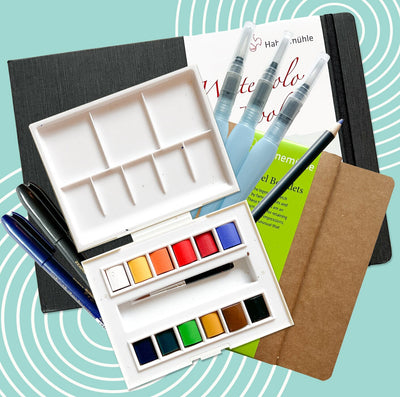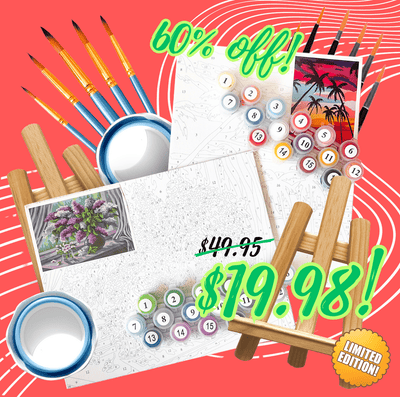There are many complex factors that go into the ways that an artistic tradition develops, including the philosophies and histories of the artists involved. When examining the differences between traditional Chinese and Western art, we see differences in composition, medium, use of color and tone, perspective, and the list goes on. While much of traditional Chinese art intended to represent a particular expression of a scene or landscape, traditional Western art, even from its early development, was often more interested in developing accuracy.
These differences likely come from the different philosophies that dominated these artistic cultures as they developed. While Chinese art, influenced by Taoism and Buddhism, was more interested in finding an eternal expression in a scene. Western art tended to be more influenced by Christian philosophy and sought to accurately represent scenes and landscapes as a mirror of the God’s nature.
In later years both of these art forms would change and develop, depending on what becomes important in their artistic culture, as well as through a cultural exchange of ideas and techniques.
 "Summer Mountain" by Qu Ding 1050 AD
"Summer Mountain" by Qu Ding 1050 AD
A Brief History of Chinese Painting
The majority of traditional Chinese paintings are painted using a brush dipped in ink or pigment, which is then applied to paper or silk. Finished paintings are often hung as scrolls. Other substrates may include walls, porcelain, or lacquer-ware.
Early Chinese art from the Han (206BC-220AD) to the Tang (618-907 AD) dynasties depicted detailed portraits of royal courts, including emperors and the Imperial lifestyle. The Tang dynasty also experienced the development of the more freeform style of landscape painting that came to dominate traditional Chinese art. The 'Golden Age of Chinese Landscape Painting' took place between the Five Dynasties period (907-960) and the Northern Song Period (960-1127). Under the Yuan Dynasty (1279-1368), it becomes common for painters to add calligraphic poetry to landscape works.
Chinese art and painting have been influenced by Chinese philosophies of Buddhism, Confucianism, and particularly Taoism, which seeks to show a sense of harmony between humans and the larger world. This allows painters to work their personal feelings and emotions into how they represent a landscape. White space in Chinese painting is intentional to invite viewers to think and interpret the piece for themselves, filling the void with their own imagination and viewing experience.
Due to the prevalence of landscape painting in Chinese art, much of Chinese traditional painting developed six common symbols, including people, mountains, water, clouds, trees, and rocks. Using these key symbols, Chinese art rarely uses shading or color to represent elements of the scene, such as whether it’s daytime or nighttime; instead, it uses symbols, such as a moon, to suggest what’s happening in a scene.
By the 1700s and 1800s, Western art and the cultural exchange began having a strong influence on Chinese painting. This cultural exchanged not only meant that some Chinese painters brought Western techniques back home to China, but it also resulted in increased reliance on expression in the West.
Chinese Painting and Composition
Composition is very important for Chinese painting, making the overall structure of the painting as important as the images depicted. To maintain balance, some primary objects are thought of as “hosts” and other smaller or more dependent objects are considered to be “guests”. Hosts might include larger mountain forms, while guests could include trees or people.
Composition becomes doubly important since Chinese painters typically use very limited palettes or paint entirely in black and white. Elements of shading that traditional western art tries to more fully render are instead simplified or suggested in traditional Chinese art. To create more detailed shading, Chinese artists will typically dilute their ink with water, similar to water-color painting. In some cases, artists will use ink of different colors to add to the style and feel of a painting. The contrasts are often kept very simple to give the viewer more space to think in the image.
Chinese Painting and Calligraphy
Chinese ink landscape painting uses the same tools as Chinese calligraphy. These simply include ink and a brush. This also means that calligraphy plays a large part in painting composition and interpretation.
In some cases, the discipline necessary for painting the unique brushstrokes of a Chinese landscape may come from calligraphy study, which every literate Chinese person would have had to learn. Some practitioners of calligraphy would go on to develop a personal style which would influence their painting brushstrokes.
Painters of the Yuan Dynasty began adding poetry in the form of calligraphy to their landscape paintings. This poetry gives the artists another means of expression to add further feeling to a piece.
Comparisons Between Chinese and Western Art
- Expressive vs. Representational Art - Chinese painters often depict nature, taking a unique, imaginative, and often expressive approach to representing what they see in nature. This may come from the Taoist principle of being in harmony with nature. The history of Western painting, however, tends to be more representational, using shape, lighting, and shading to create a more accurate depiction.
- Dynamic Perspectives vs. Fixed Perspectives - Chinese artists will frequently use dynamic perspectives that allow the viewer a sense of movement without realism. This might cause the painting to look like it is wandering through the landscape, rather than remaining in one fixed point. In some cases, the opposite may occur, and a Chinese painting may seem to have a flattened perspective that conflates time and space, showing different spaces in one composition or different things happening across time all at once. Western perspectives, on the other hand, tend to be fixed to invite a sense of realism and accuracy. This might make them less dynamic, creating more of a photograph-like representation.
- Minimalism vs. Full Rendering or Shading - Chinese art is sparing with its brushstrokes which allows it to have a more minimalistic appearance. This also means emphasizing the feeling and expression behind each brushstroke. This lack of reliance on light rendering may be the result of looking for a more eternal expression that is not changeable by light and shadow. Western art often uses more technical brushstrokes to accurately render the light and shading of an object.
- Negative or White-space vs. Filling the Canvas - Chinese paintings will often have negative or white space and unpainted areas. These spaces are considered to be as important to the painting and overall composition as the painted areas since they offer space for interpretation. Western art tends to fill the canvas more, while negative spaces are represented by darkness, gradients, or single colors.
In both cultures, we can see the importance that philosophy and ideas play in how individuals create their art and what it means to them.


